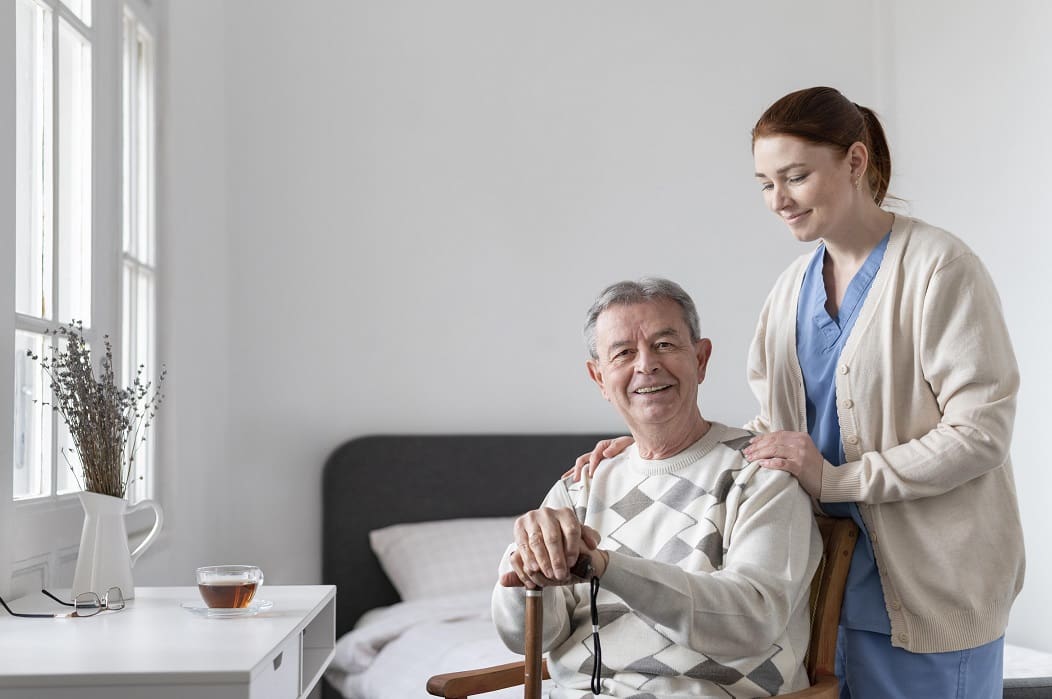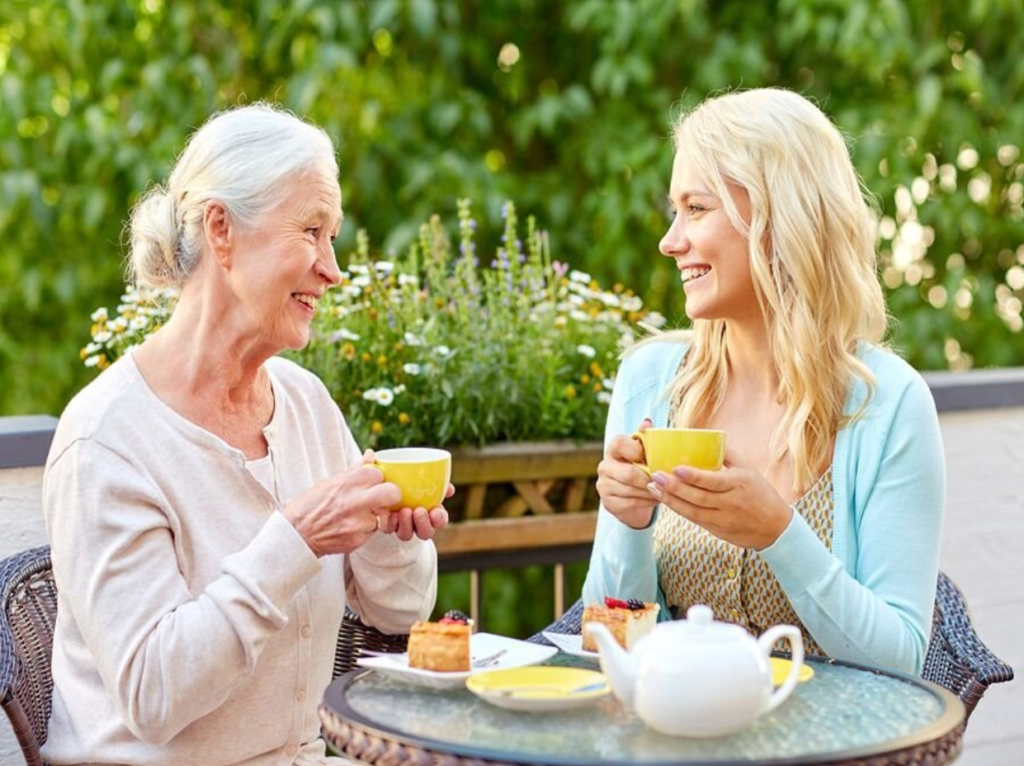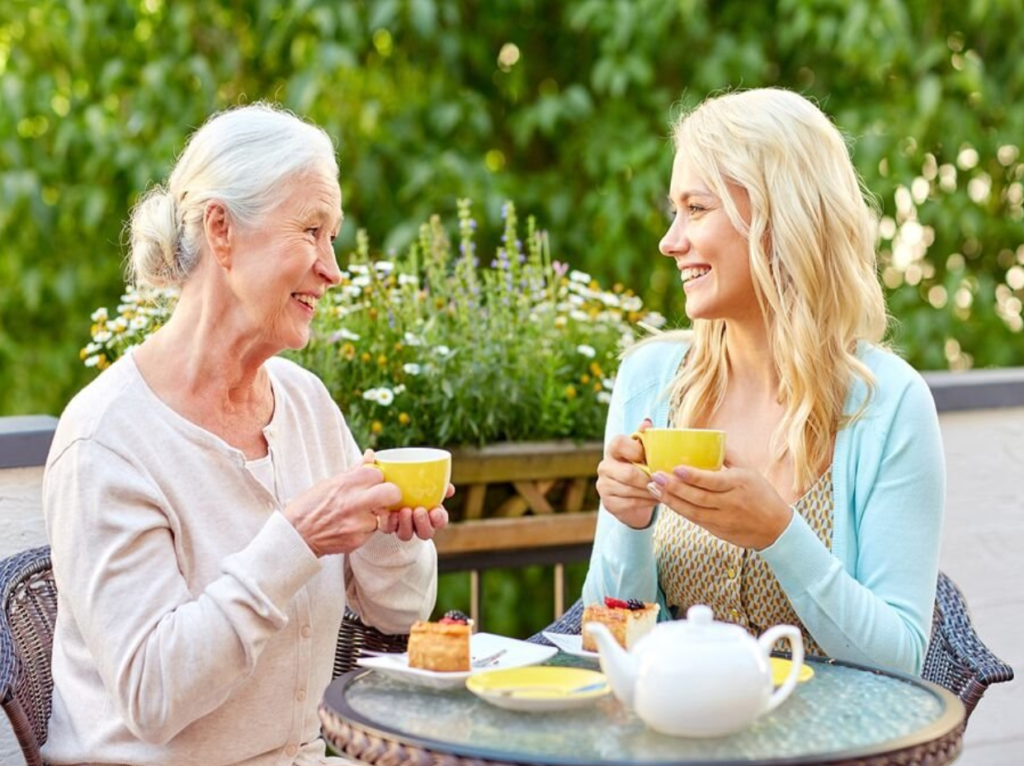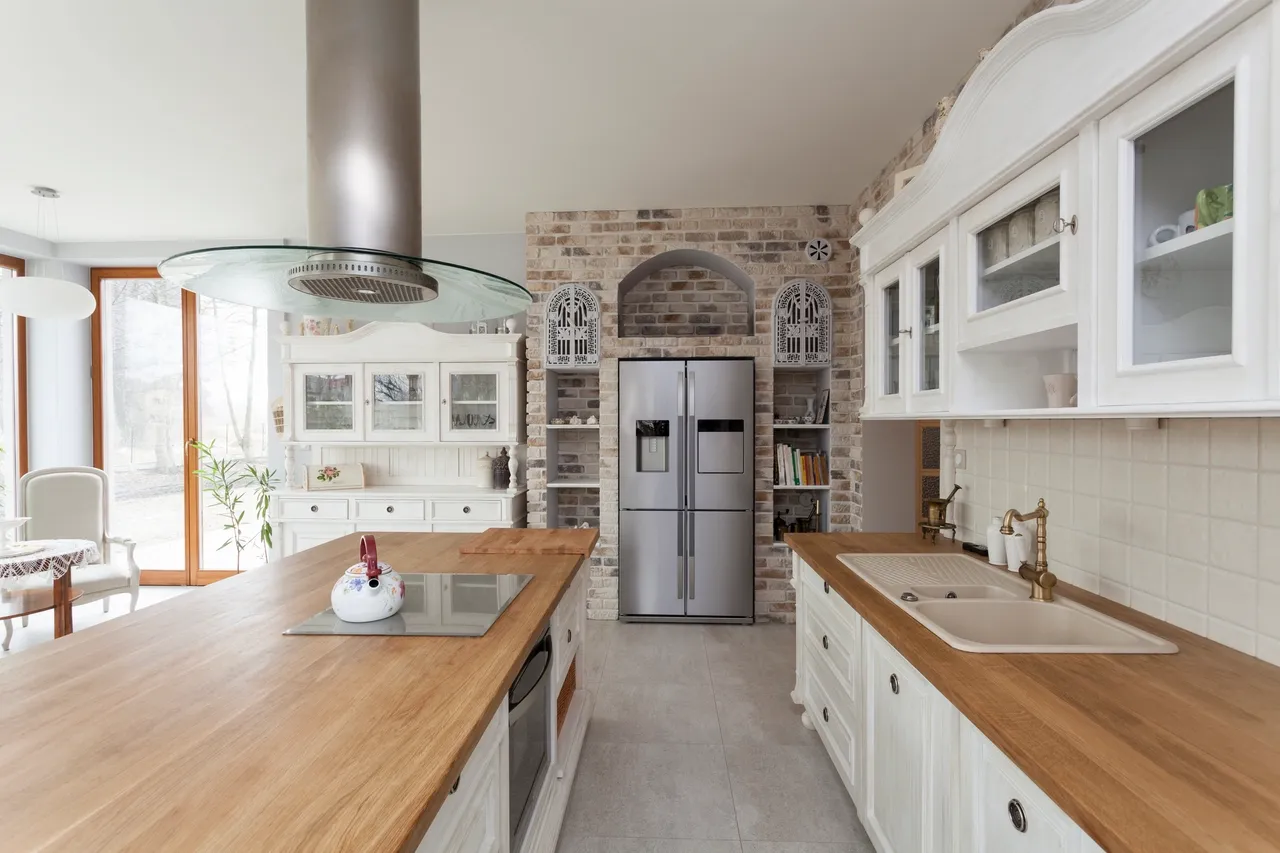
Caring For An Elderly From Afar: How to Support a Parent You Can’t Always Be There For
June 24th, 2025Caregiver Agency, Caregiver Service, caregiver support, Home Care, In Home Care,
When someone you love needs more care than ever—and you live too far away to knock on the door—it can feel like your hands are tied, when you are Caring For An Elderly From Afar. But it does not need to be as overwhelming . Thanks to a wave of practical tech and service options, long-distance caregiving has become something you can manage proactively, thoughtfully, and with real peace of mind. This isn’t about replacing presence with gadgets. It’s about staying present in new ways, with tools that extend your reach and voice across the miles.
Emergency Response
One of the first things you worry about? What happens if something goes wrong and no one’s there. That’s why finding a top-rated fall detection system is a non-negotiable starting point. These setups do more than buzz for help, they detect motion, sense impact, and alert emergency contacts without the need to press a button. Some even track location changes
and unusual patterns, so you get a heads-up before it becomes a headline. When seconds count, these tools deliver. No guesswork. Just action.
Companionship
Being alone too often isn’t just hard, it’s harmful. But tech has gotten kinder. Enter the new generation of digital presence: AI companions to help fight loneliness. These voice-driven systems talk, play music, remind about meds, even initiate check-ins based on routines. And this isn’t about faking family, it’s about creating rhythm, easing silence, and giving you another channel to listen through. A little presence goes a long way.
Home Safety
Sometimes safety looks like a locked back door. Or a hallway that lights up when footsteps hit the floor. That’s what smart sensors boost safety are for. Think appliance shut‑offs, voice‑activated lighting, even alerts if the stove stays on too long. You don’t have to redesign the house, just tune it to respond better. The right upgrade can feel like a second set of eyes.
Doctor Access Medical help shouldn’t hinge on someone driving across town. With available telehealth options, your loved one can see their doctor on a screen, send secure messages, and manage prescriptions without ever leaving the couch. These platforms aren’t just convenient, they’re clarifying. You stay in the loop. They get care when it matters. And you both sleep easier.
Location Tracking
Wandering is rare until it’s not. A single afternoon out of bounds can shift everything. If you’re worried, check out whether GPS tracking is worth it for your situation. These devices can send real-time location alerts, trigger notifications if boundaries are crossed, and let you know someone made it home. Freedom matters, but so does knowing when freedom starts to fray.
Financial Clarity
Money talk gets messy, fast. Especially when siblings share caregiving duties across state lines. Tools like shared spreadsheets help, but finding a free budget template online makes things less abstract. It gives you something concrete to point at. You’ll still need conversations, but now they’ll start with numbers, not feelings.
Caregiver Support
Sometimes the signs aren’t loud. They’re quiet. Missed meals. Clothes worn backward. Conversations that repeat like clockwork. That’s when it might be time to explore in-home support, even just a few hours a day. Services like Polish Care Services can step in gently—offering companionship, personal care, and daily help that respects independence while adding structure. It’s not surrendering control—it’s keeping things steady before they spiral.
You don’t need to do it all. But you do need to stay connected, to people, to routines, to the little red flags that pop up when something shifts. Tech won’t love your parent the way you do. But it can help you show up, stay close, and make the distance feel smaller than it is. That’s the goal.
Credit: Denise Long

Top Caregiver Agency Cleaning Services: Elderly & Disabled In-Home Support
February 10th, 2025Caregiver Service, Home Care, Long Term Care,

Providing care for the elderly and disabled depends not only upon personal assistance, but also their clean and healthful living surroundings. A caregiver agency ensures excellent support to geriatric and incapacitated individuals at home, sustaining their independence under familiar surroundings simultaneously. Residential cleaning services play vital roles in developing a safe hygienic surrounding and comfortable and healthy home settings.
A mix of senior consideration administrations, old consideration administrations, and homecare administrations is great for families searching for complete help. These administrations furnish help with everyday undertakings as well as upgrade close to home prosperity, diminish wellbeing gambles, and advance a superior personal satisfaction.
Why a Caregiver Agency is Essential for the Elderly and Disabled
An expert parental figure office is a fundamental asset for families who need to guarantee that their old or crippled friends and family get customized care. As people age or live with handicaps, it becomes challenging for them to do regular exercises like washing, dressing, and planning feasts. The presence of a prepared parental figure empowers them to approach their everyday daily schedule while keeping them protected and agreeable.
Older care services, including a caregiver agency, aim to help seniors remain in their homes for as long as possible while receiving the proper support. Many seniors prefer staying at home instead of moving into nursing homes, and they often require significant assistance with transportation, medication management, companionship, and even light housekeeping to ensure successful aging in place.
For incapacitated individuals, proficient consideration empowers them to achieve their day to day exercises absent a lot of issues. Whether it is tied in with practicing or carrying out some clinical gear related exercises, or even everyday reassurance, a guardian deals with every one of their requirements. Admittance to trustworthy homecare administrations empowers incapacitated individuals to carry on with an existence of fulfillment while holding their freedom.
Senior Care Services: Enhancing Comfort and Well-Being
Similar to other professions, proper training is also essential in the field of caring for seniors. Senior care services are more than just helping older adults with daily activities. It is aimed at enhancing the well being of elderly persons by attending to their mental, emotional and physical health.
With aging comes the burden of chronic medical conditions, limited mobility, and decline of cognitive functions. Caregivers are trained to manage such challenges with the required skill and empathy. They serve as companions to help minimize feelings of loneliness and stimulate the elderly mentally and physically while ensuring medication reminders as well as adherence to dietary restrictions.
However, numerous aged persons require more focused attention especially those suffering from dementia or Alzheimer’s disease. Such caregivers offer customized approaches aimed at reducing the anxiety and confusion that elderly people may feel, allowing them to achieve a secure feeling in their surroundings.
Homecare Services: Personalized Assistance for Independent Living
Assisted living facilities may not be appropriate for everyone, but with homecare services, the elderly and the disabled can receive help right in their homes. Homecare providers develop specific plans for each patient that outlines their specific requirements so that they can receive optimal care.
Apart from bathing, dressing, cooking, and basic cleaning, the provider’s aid can specialize in medical aspects of caregiving too. This includes monitoring vital signs, actively participating in rehab exercises, and working with other medical staff.
Homecare’s greatest strength stems from the fact that it is able to provide a comfort zone for the disabled and older individuals. In contrast to the institutionalized form of care which may isolate people, home care allows elderly patients to continue with their ordinary tasks and engage with their family members.
The Role of Residential Cleaning in Senior and Disability Care
The job of providing care improves an individual’s life, while private cleaning administrations ensure a protected and sound living space. Cleanness in a home climate is fundamental for guaranteeing cleanliness and prosperity.
More established grown-ups may need actual portability, making it tricky for them to clean their homes. Fundamental errands like cleaning, vacuuming, and sanitizing become overwhelming undertakings, bringing about a development of residue and allergens. Private cleaning administrations ensure homes are liberated from allergens and coordinated in a way that is helpful for the occupants’ wellbeing.
The lack of sanitation can pose serious consequences for the disabled, including tripping, fungus forming, or even bacterial infections as a worst case scenario. Professional cleaners guarantee that every space is properly maintained, improving the chances of utmost comfort while drastically reducing the risk of illness.
Moreover, new clients that require home care feel more providers when their surroundings are uncluttered, which boosts their mental wellbeing. A clean environment lowers their stress levels dramatically while creating a positive feeling around them.
How Caregiving and Cleaning Services Work Together
Maintaining a tidy space is fundamental for caregiving to be done effectively. If caregivers do their work in a positive space, they will pour their all into taking care of the client’s needs. This is the reason most families prefer agencies that provide both caregiving and cleaning services to the household.
This way, the elderly and disabled can receive assistance from highly trained caregivers while also benefiting from the services of a professional cleaner who maintains sanitation, disinfects high-touch areas, and organizes the home.
Homes that are clean are less likely to expose elderly persons with low immune systems to infections. Similarly, a disabled person gains from uncluttered environments that reduce their chance of falling and getting injured.
Families using an agency that provides both caregiving and cleaning services, do not have to worry about anything. They can easily manage the care of their loved ones without dealing with multiple service providers.
Finding the Right Caregiver Agency and Cleaning Service
Picking a parental figure organization is vital to guarantee that the old and incapacitated get quality consideration and backing. Search for organizations that have thoroughly prepared and experienced guardians that can give proficient and delicate consideration. It is important that the chosen guardian can work inside an individualized consideration plan that takes care of the individual’s prerequisites.
With regards to housekeeping, families ought to consider working with organizations that don’t utilize unsafe synthetic compounds and are delicate to the cleaning needs of older individuals that might have sensitivities or issues with relaxing. There are additionally high sterilization principles and methods that should be stuck to keep the home liberated from microorganisms and safe.
The assignment of really focusing on the old becomes more straightforward when an organization offers both senior consideration administrations and housekeeping administrations. Parental figures and cleaning staff will team up and ensure that all the consideration perspectives are cooked for.
Comprehensive Care for a Better Quality of Life
The aid of elderly and physically challenged persons is not just a medical issue, but also concerns the creation of an atmosphere conducive for the person to be at ease, feel secure, and earn some respect. Managed care agencies are responsible for making sure there is personalized assistance and maintaining sanitation and cleanliness through residential cleaning services.
For caregivers or agencies that cater to families, providing both care and cleaning services makes coordination easier. Senior citizens and physically challenged persons should be able to live happily and independently at home with the help of caring caregivers and cleaners working hand in hand.
For the family spending money on professional homecare service means the person will be taken care of and the surroundings healthy and clean. Daily errands, visits, or cleaning the elderly person’s home requires a comprehensive approach to caregiving and cleaning. The person in need will have an easier, more comfortable life, and the rest of the family can enjoy less stress.

Aging in Place: Transform Homes for Senior Services & Home Care
December 2nd, 2023aging in place, Home Care, Polish Care Services, Senior Services,
As the population continues to age, more and more seniors are expressing their desire to age in place – to remain in the comfort and familiarity of their homes as they grow older. However, to facilitate this, it is crucial to make homes more accessible and adaptable for the unique needs of seniors. By incorporating senior services and home care into the very design and modifications of their homes, we can create spaces that not only meet their current needs but also support their independence, safety, and overall well-being. In this blog, we will explore various strategies and modifications that can transform homes into accessible and senior-friendly environments, promoting comfortable and joyful aging in place.
Assessing Current Needs
To begin the process of making a home more accessible for seniors, a thorough assessment of their specific needs is essential. This can involve consulting with professionals, such as occupational therapists or geriatric care managers, who can provide valuable insights based on their expertise. Understanding the physical, cognitive, and emotional abilities of the seniors will help determine the areas that require modification for improved accessibility.
Ensure Safety and Mobility
Safety should be a top priority when adapting a home for aging in place. Installing sturdy handrails along staircases and in bathrooms, securing loose rugs, and eliminating tripping hazards should be initial steps. Widening doorways and hallways to accommodate mobility aids like walkers or wheelchairs is crucial. Installing non-slip flooring in high-risk areas, such as bathrooms, can significantly reduce the risk of falls. Additionally, well-placed and bright lighting throughout the house is essential for seniors with visual impairments.
Bedroom and Bathroom Modifications
Bedrooms and bathrooms are two areas that require careful consideration when adapting homes for seniors. Bedrooms can be modified by ensuring a comfortable mattress of appropriate height, installing grab bars near the bed, and arranging furniture to allow for unobstructed movement. Adequate lighting and strategically placed nightlights can further enhance safety.
Bathrooms pose specific challenges for seniors due to slippery surfaces and limited maneuverability. Installing grab bars near the toilet, shower, and bathtub can provide much-needed support. A walk-in shower or a seated shower with handheld fixtures can offer convenience and safety. Non-slip mats and contrasting colors to define edges are additional modifications that can make bathrooms safer.
Kitchen and Dining Area Modifications
The kitchen is often the heart of a home, and making it more accessible can empower seniors in their daily routines. Lowering countertops and cabinets, installing pull-out shelves and Lazy Susans, and replacing traditional knobs with lever-style handles can reduce strain and enhance accessibility. Installing appliances at appropriate heights and incorporating tactile markings on dials can also facilitate independent cooking.
In the dining area, potential modifications can include using chairs with armrests for stability, providing ergonomic utensils, and ensuring adequate lighting for ease of dining.
Technological Solutions
Advancements in technology offer exciting opportunities to enhance accessibility for seniors aging in place. Smart home technologies, such as voice-activated assistants and automated lighting systems, can make controlling various aspects of the home easier for seniors with mobility or cognitive challenges. Telehealth devices and wearable monitoring systems enable remote healthcare services, ensuring timely interventions in case of emergencies.
Conclusion
Creating homes that are more accessible for seniors is not only about physical modifications but also about promoting emotional well-being and independence. By incorporating senior services and home care into the very fabric of the home, we can empower seniors to live fulfilling lives in their cherished spaces. From assessing current needs to ensuring safety, mobility, and comfort, modifications such as widening doorways, installing grab bars, and incorporating technological solutions can significantly improve the quality of life for seniors aging in place. As society continues to recognize the importance of elderly individuals’ active participation, it is our responsibility to create inclusive environments that allow them to thrive gracefully. Let us embrace the concept of aging in place and strive to make every home a sanctuary where senior citizens can find solace, security, and lasting happiness.
Credit: Kasia Sutkowski for Polish Care Services Senior Services Division

Caring for Seniors: Caring for Seniors During Changing Seasons
September 7th, 2020aging in place, Alzheimer's Care, Caregiver Service, Companion Caregiver, Companion Senior Care, Home Care, In Home Care, Preparing for the Holiday, Retirement Plans for Seniors, Senior Care Services, Senior Living, Senior Services, Seniors, Summer Activities for Seniors, Uncategorized,
As we head into another time of the year, start thinking about long term care for seniors at home during each season. Every time of the year has unique challenges for the elderly population. Keep reading to learn how to care for seniors during season change such as autumn, winter, spring, and summer.
Care During Autumn
Autumn is the season to prepare in-home care clients for the winter ahead. The flu season officially begins in October. So start asking your client’s family or nurse to arrange for a flu vaccine in September or early October. Go through the client’s over-the-counter medicines and get rid of any cold-related medication or supplies that have expired. Replace the expired supplies and stock up on other things like tissues, cough drops, and nose spray if applicable.
Fill the pantry with cans of healthy soups and find recipes for warm dishes that can be put in the crockpot for easy meals. Fix any drafty spots in the house.
Don’t forget to go through existing cold weather clothes and replace anything that’s no longer wearable. Make sure the client has enough socks, sweaters, warm pajamas, and blankets to keep them cozy.
Care During Winter
Winter is the coldest time of year and can present the most risk to seniors at home with increased fall risks and household risks. One of the most important steps to take is to prepare the home for winter. Caregivers should notify the client or their family of any potential hazards around the home such as a lack of fire extinguishers around the fireplace, stairs that present a fall hazard when wet, or carbon monoxide detectors in need of batteries.
Make up an emergency kit with a flashlight, warm blankets, a radio, backup batteries, water, and nonperishable food to last for several days in case in-home visits cannot be made. Install non-slip mats under rugs and in any room where the client may slip and fall. Keep shoes on mats inside the house to keep puddles from forming on the floor if they’re wet. Finally, keep areas well-lighted as it gets dark to prevent clients from falling over objects.
Care During Spring
Spring is a season of fresh starts and is a time for caregivers providing in-home senior care to reassess things in the home. Examples of this include making sure that the medication list for the client is current and has all prescribed medications as well as vitamins or supplements. Any expired or discontinued medications should put in a separate location until a family member or client’s home care nurse can look at them or disposed of if possible.
Evaluate the rooms used by the client for any repairs or improvements to be made. Consider installing grab bars and non-slip mats in the bathroom, putting appliances and dishes within easy reach in the kitchen, and installing a nightlight in the bedroom. Move clothes and grooming items within reach for the client to use and make sure they can reach the phone or medic-alert devices from the bed.
Lastly, secure cords out of the way and get rid of clutter in the home that presents an ambulation hazard.
Care During Summer
When the weather begins to heat up, seniors face new challenges. Heat can put added stress and pressure on the elderly. It’s best to keep them cool and indoors. Avoid any strenuous activities. If the client wants to do a physical activity like take a walk, it’s best to do it early in the morning while it’s still cool. Keep them hydrated throughout the day with water and avoid drinks with alcohol or caffeine in it. Encourage wearing light layers and keep the home cool by running a fan or using solar curtains.
Prepare meals that are light and healthy like salads and avoid heavy meals. Stock up on popsicles or other frozen items that help keep clients hydrated and cool. Offer a cool shower or bath to help beat the heat and use a cool washcloth on the back of the neck when sitting to help alleviate feeling hot.
If the client wants to go out, go to places with air conditioning like a library, coffee shop, or mall.
Every season has its care benefits and care challenges. The most important thing to remember is to prepare in advance. The more prepared a caregiver is for each season, the less stressful it will be for the senior. If you’re looking for a thoughtful and prepared caregiver, contact Polish Care Services. Our staff will be happy to match our caregivers to your loved ones.

Caring for Seniors: The Caregiver Option
July 7th, 2020Caregiver Employment, Caregiver Service, Home Care, Home Healthcare, Homecare, House Cleaning, In Home Care, in home care assistance, Long Term Care, Polish Care Services, Senior Care Services,
If your elderly loved one is struggling with daily activities like shopping, bathing, or dressing independently, and wants to stay in their home, consider hiring a caregiver. This article discusses what a caregiver is, what their duties are, and tips for hiring one for your loved one.
What is a Caregiver?
A caregiver is someone who provides in-home care for someone who needs extra help doing daily tasks on an ongoing basis. They can also be employed when a loved one is recovering from a temporary illness or surgery.
What a Caregiver Does and Limits to Consider
A caregiver can help with things like driving to appointments, shopping, dressing, and bathing and serve as companions. Caregivers can also help seniors with any prescribed exercises given by therapists, attend appointments, and report any health concerns to family members or doctors that they observe. The duties of the caregiver will ultimately depend on the care needs of a loved one. But there are limits.
When hiring a caregiver, consider what the care needs of your loved one are realistically speaking. Senior care needs can change over time. So be prepared to consider other care options such as increasing hours, round-the-clock care, or moving to a facility if that is what is necessary and appropriate.
Things to Consider When Hiring a Caregiver
Considering your loved one’s care needs is important but it’s not the only thing you should factor in.
Finances- Insurance does not cover the cost of caregivers the majority of the time. Can your loved one or family afford to pay for caregivers now and increased needs in the future?
Family Agreement- Make sure that your loved one and family members involved with them and their care agree with the decision. If your loved one or other family members have different ideas about who the caregiver should be, it can cause significant conflict.
The Right Fit- Hiring a caregiver independently or going with the first agency you call may not be the right fit for your loved one. Talk with your loved one and family, ask questions of prospective agencies and do your research before you hire anyone.
If you’re not sure where to start in your caregiver search, contact Polish Care Services. Our staff will be happy to discuss our services with you!

Using Ultraviolet UV Rays for Coronavirus Covid-19 Sanitizing
April 19th, 2020aging in place, Caregiver Employment, Caregiver Service, Companion Caregiver, Dementia Care, Elderly Care, Home Care, Home Healthcare, Homecare, House Cleaning, In Home Care, Long Term Care, Polish Care Services, Senior Care Services,
Because of the Coronavirus Covid-19 pandemic, Polish Care Services team has been researching global solutions to eliminate viruses and bacteria, to better understand how to improve on care quality for its seniors and disabled clients, also to improve its residential and commercial cleaning operations.
Our primary source has always been the CDC and its guidelines. However we believe in gathering and analyzing enough scientific data from credible sources to make informed decisions, for more effective outcomes.
During our research for a no mess solution, we were enlightened about the benefits of Ultraviolet rays for sterilization purposes.
Coronavirus Covid-19 Survival and Transmission
According to the Annual Reviews Covid-19 type viruses transmission is seasonal and cyclical and will primarily occur during December through April. Transmission was found to be most efficient under 23°C/ 73.4°F/ 30% relative humidity RH conditions, and least efficient at 23°C/73.4°F/ 50% RH and 5°C /73.4° F/ 70% RH.
What is Ultra Violet light
Ultraviolet light is a type of electromagnetic radiation that is used for for summer tans, sunburns also makes black-light posters glow. However, too much exposure to UV radiation is damaging to living tissue.
UV is generally divided into three sub-bands:
● UVA, or near UV (315–400 nm)
● UVB, or middle UV (280–315 nm)
● UVC, or far UV (180–280 nm)
The greater the intensity and exposure, the more dangerous it is for organisms. UV-C is considered the most safe when used with precautions.
How does it Work
According to the National Institutes of Health NIH Ultraviolet short-wave radiation destroys DNA in living microorganisms.
The effectiveness of UVC’s is directly related to its intensity and exposure time.
Although UV-C LEDs are relatively new to the commercial market, it is becoming more popular in global communities.
UV-C LEDs targets a specific wavelength needed for disinfection. This is important considering that pathogens vary in their sensitivity to specific UV wavelengths. The benefits of LEDs are unlimited daily cycle, instant on/off and mercury free. Most handheld ultraviolet LED sanitizer wands has a shield that minimize light and radiation contact with user.
What are the Dangers
Dangers of too much exposure to Ultraviolet (UV) radiation is a known cause of skin cancer, skin aging, eye damage, and may affect the immune system.
Further research is needed for the consistent use of Ultraviolet sterilization, although most studies shows that the use of these devices with the proper precautions, can be effective and relatively safe. Virus in hard to reach areas such as cracks and crevices may not have the adequate exposure to be eradicated, and can still survive.
It is recommended to use sanitizing solutions with ultraviolet rays to be more effective.
Best Solutions
Best solutions are still social distancing, hand washing, disinfecting surfaces, and wearing mask when necessary. If possible, seniors and those with preexisting conditions should avoid areas with large groups or gatherings, as the risk of contracting the virus is more elevated in these settings.
In home care with a personal caregiver may be the best viable option. Without a vaccine, and because of the cyclical nature of the Covid-19 virus, this indicates occurrences will be seasonal and cyclical December – April.
Polish Care Services provides caregivers for seniors and disabled, we also provide cleaners for homes, and janitors for offices and business.
Please visit us at polishcareservices.com or phone 860-255-8278 or email care@polishcareservices.com so we can better understand your needs.
